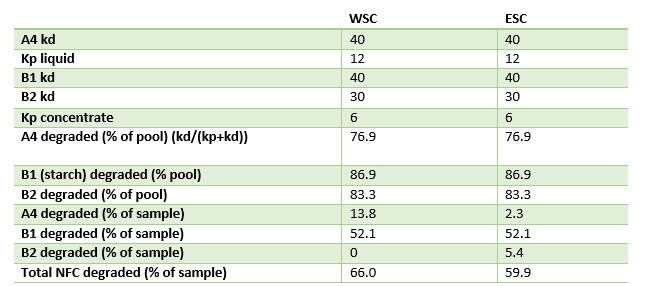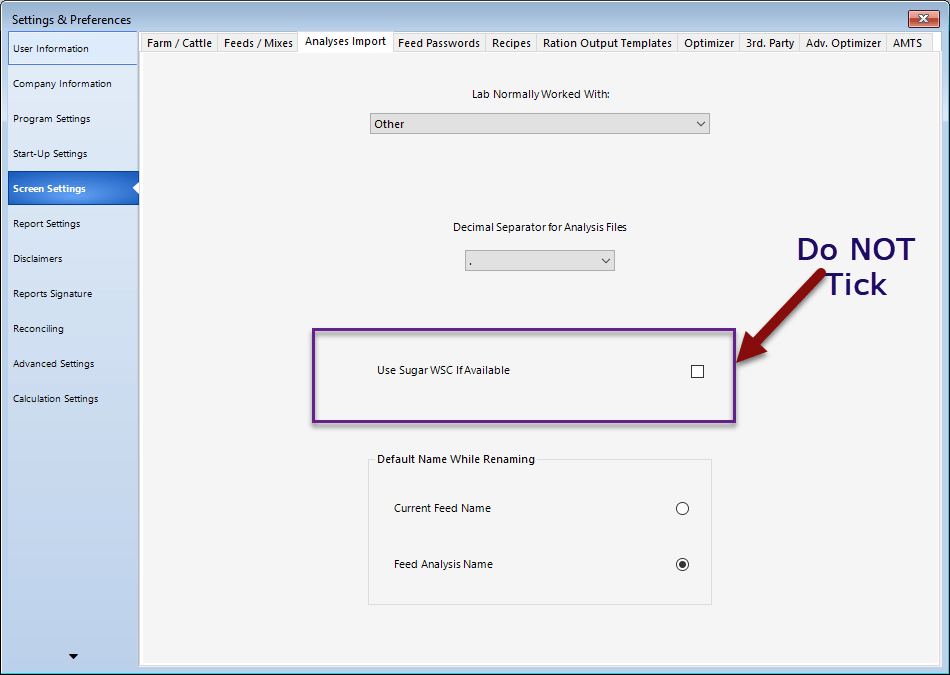Over the past decades, dairy cattle diet formulation has involved feeding non-traditional ingredients either for economic (lower feed price) or efficiency (better nutrient availability), or both, reasons. We’ve been seeing an increased number of ingredients that are ‘cooked’. These include things like bakery by-products, cereal by-products, cooked grains, etc. I’ve been playing with some different ones from a plant here in New York and am really excited by what we can do with increased starch processing. However, in looking closer at the accounting of these ingredients we found a problem with the starch values in the CNCPS model.
WSC vs ESC and why
The two most common methods for measuring the sugar content in feeds are ethanol soluble carbohydrate (ESC)—sample is soaked in 80% ethanol and then filtered and water soluble carbohydrate (WSC)—a hot water extraction of a sample . In the illustration from DairyLand Laboratories we can see what each method includes. WSC has become the recommended analysis method for both equine and ruminant use. For horses, it measures more fully the fructans in the feed, high levels of which can lead to laminitis. For ruminant nutrition it is thought that WSC better covers all sugars relevant in ruminant nutrition.

Problems with Cooked Feeds and WSC
One of the things we see when we look at feeds utilizing these advanced processing methods is understanding classical starch numbers in relation to WSC. We have done a few samples where we’ve run ESC and WSC side-by-side. It comes through clearly that these methods do not give us the same answers. ESC extraction typically gives us a mix of simple sugars and some short-chain fructans. WSC contains simple sugars, fructans, and other medium chain carbohydrates. Typically, WSC ferments like sugars: in feeds like fresh pasture, these WSC are critically important when describing the fermentation behavior observed. With these cooked products though, we have a problem. We are basically coming up with a water-soluble starch. Is that water soluble starch a sugar or a starch to the cow? We are not quite sure yet. These methods do introduce a problem to the model right now.
Let’s look at an example.
In this example, the starch content was 60% and the NFC was 70. We calculate soluble fiber by difference. Given that these water soluble carbohydrates also analyze as starch, we have a double accounting error. Think of this just like when we switched from aNDF to aNDFom where the ash was double accounted in the soluble fiber calculation.

As you can see, by basically double accounting for that starch, our soluble fiber pool varies by 15 units (from -8 to +7). The Mass Check (if all other components were constant) would be 108 for the WSC column. Internally, AMTS would set the soluble fiber to 0 so the difference in soluble fiber would effectively be 7 units.
That may not seem like a big deal. However, moving these pools around impacts which kd and kp is used. Given that each pool has its own kd, the difference between sugar and soluble fiber could be significant. Additionally, sugars flow with the liquid phase with the model whereas soluble fiber and starch (when talking about concentrates) flow with the concentrate phase. Here we could be talking 12 vs 6% per hour.
So let’s look at that same example using the different kd and kps.

You can see from the above table that with these cooked products, we would be over-estimating the of NFC potentially degraded by nearly 10%. This relates to an over-estimation of microbial yield and MP flow.
Now, there are lots of things we do not know. Last week, we had a conference call with three of the labs and Mike Van Amburgh about all this. We really don’t know what these water soluble carbohydrates are in these cooked products. Additionally, we don’t know what the rates are. We have some ideas of what they are and the kds for the starch pool need to be set correctly. What we do know is that using WSC for these cooked products results in incorrect pool sizes. An agreed upon approach was determined.
Recommendations:
Here is the recommendation for now: If you are using bakery by-products or a cooked grain, use ESC for sugar analysis and let all the starch reside in the B1 CHO pool. While not perfect, it is giving us more consistent pool size calculations. If you get XML files from labs and they report both, make sure the ESC is used for sugar post-importing.

There will be more to come on this topic over the next few years we hope!
